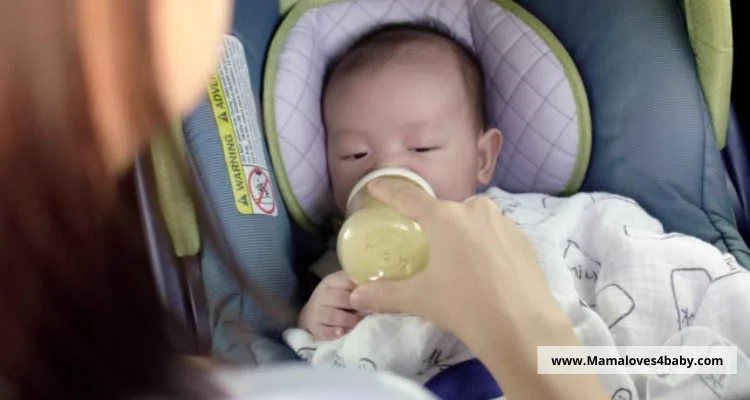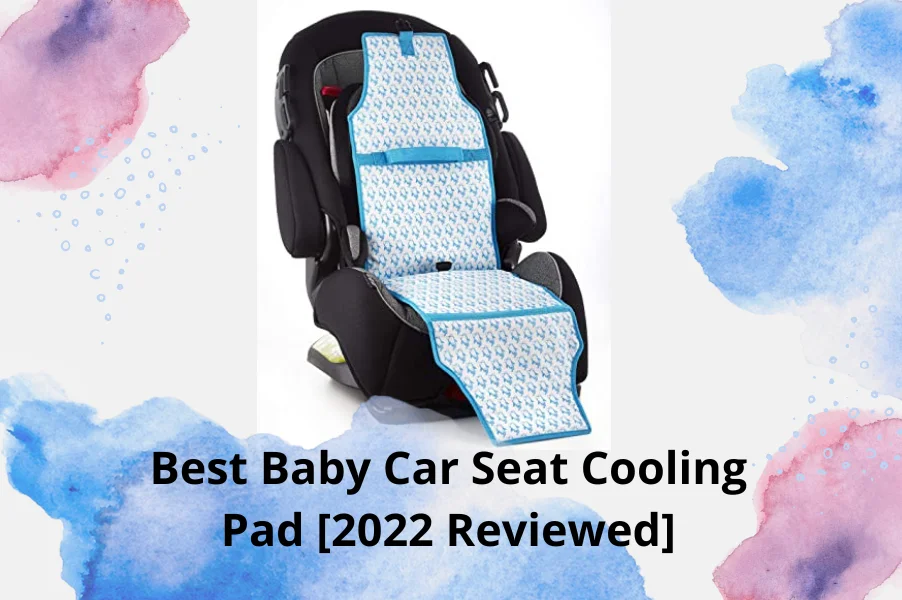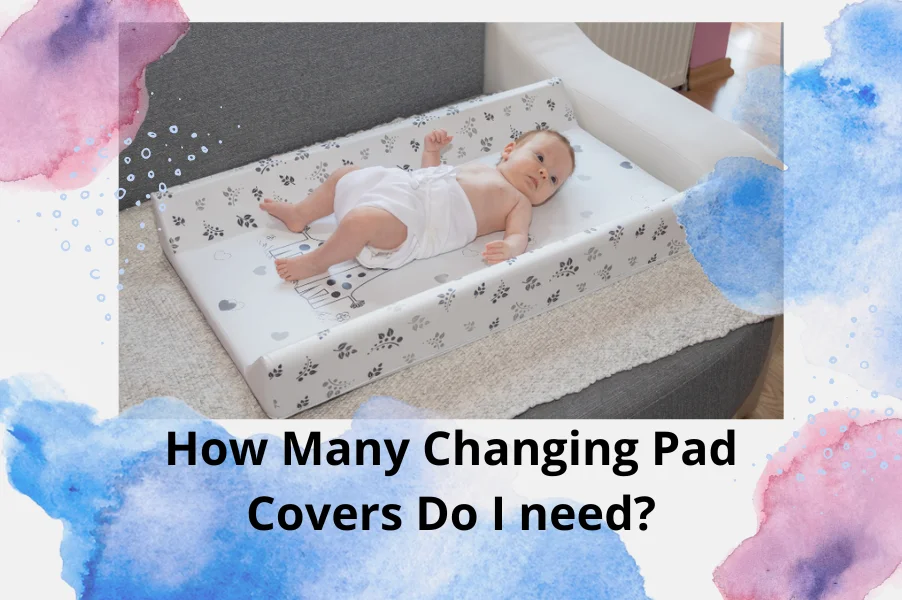Can I feed baby in car seat? The answer is yes, you CAN feed your baby while they’re in their car seat. However, there are a few things new parents need to remember to do safely. This blog post will discuss tips for successfully feeding your babies while they’re strapped into their car seats with all the safety tips and necessary travel feeding supplies.
The American Academy of Pediatrics suggests that all infants under two ride in a rear-facing car seat whenever possible. It is because rear-facing car seats are much safer for young children and offer the best protection in a car accident.
Read Also: 7 Double strollers for disney world
Can you feed baby in car seat?
You may need to take your child out of the car seat on long rides to feed them or change their diaper. In this case, you should know how long your child can be out of the car seat without compromising their safety. Because they are at a greater risk for injury if they are out for a long time and involved in a car accident.
The AAP recommends that infants under one should not be in their car seats for more than two hours. So, if you are on a long voyage, follow the two-hour rule, take your baby out, and let their body stretch. Can you take the baby out of the car seat to feed?
Taking your baby out of their seat is not recommended to feed them unless necessary. If you need to take them out, hold them securely and put them back in the seat as soon as possible.
How Can I feed baby in car seat safely?
Can i breastfeed my baby in the car? Whether bottle feeding or breastfeeding, it is possible to feed your baby safely in its car seat with these simple safety precautions.
Install your car seat correctly.
The least you want is your baby to fall out of their car seat because it wasn’t installed correctly. If you’re unsure how to install it, consult the instruction manual or watch a tutorial online. Better yet, please take it to a professional to have it installed for you.
Adjust the car seat straps so that they’re nice and snug.
The car seat strap should be nice and snug. You don’t want your baby wiggling around too much while eating, which could cause them to choke on their food.
Use a car feeding booster.
If you need to take your child out of their car seat to feed them, it is essential to make sure that they are in a safe place. A good option is to put them in a car seat feeding booster, which will allow them to sit upright and still be restrained in their seat.
Place car set in recline position
Put the car seat in a reclined position and feed the baby while still in the seat. It can be done using a bottle adapter that attaches to the seat.
Use a nursing cover or blanket if you’re breastfeeding.
It will give you some privacy while you breast feed baby in car. It will also prevent your baby from getting too distracted by everything that’s going on around them.
Burp your baby often.
Even if your baby isn’t visibly spitting up, it may still be swallowing air while they eat. Be sure to burp them frequently, so they don’t have an uncomfortable tummy ache later.
Never leave the baby unattended.
Besides all your safety measures, car seat manufacturers recommend not leaving your baby unattended, even for a quick grocery pickup.
Keep one hand on your child at all times.
It will help keep them steady and allow you to react quickly if they start choking or coughing.
Pull over if possible.
If you can find a safe place to pull over, it’s always best to do so when feeding your child. That way, you can give them your undivided attention and won’t have to worry about driving simultaneously.
Don’t forget about yourself!
It can be easy to focus on feeding your baby that you forget to eat or drink. You can bring snacks and drinks for yourself, so you don’t feel faint or dizzy later.
Car Travel With Baby: Safety Tips for feeding baby in car seat
Can you feed baby bottle in car seat? You can, but feeding a baby in the car seat can be tricky. You want to ensure that they are safe and secure, but you also don’t want to stop in your way every few minutes to feed them. However, it’s essential to ensure that the bottle is securely fastened to the seat.

Can you bottle feed baby in car seats?
You can do bottle feeding in a car seat with these best essentials. Follow these tips to help you make the most of feeding your baby while on the road:
- Ensure the car seat is secured correctly and your baby is sitting upright.
- Use car safe travel bottles. These bottles typically have a shorter and wider neck. It makes feeding your baby safe and more manageable.
- Take your baby bottle in bottle tote bags that maintain the temperature at the required level.
- Ensure your baby is in the correct infant car seat for their age, weight, and height.
- Ensure the seat is installed correctly and your baby is strapped in a chair properly.
- Ensure the car seat is in the correct position for your baby. The AAP recommends that all infants under 20 pounds be placed in a rear-facing infant car seat.
- Take breaks after 2 hours to allow your baby to stretch and move around.
- If you are changing your child’s diaper, it is vital to make sure that they are in a safe place. A good option is to put them on a changing pad or in a portable bassinet.
- If bottle feeding in the car, it’s best to ensure the bottle is securely fastened in the car seat. You can do this by using a bottle clip or a similar device.
- If you are feeding your baby breast milk, you can use a nursing cover to help keep things clean and discreet.
- Ensure you have all the supplies, portable bottle warmers, baby wipes, burp clothes, disposable sacks, diapers, a car seat cooling pad, and a first aid kit.
What Should I Feed My Child While Driving?
Suppose you need to feed babies solid items while in the moving car. Select safe food that will not cause a choking hazard while driving after feeding baby. There are many healthy and safe snacks for teething babies that you can give to your child to make the feeding process safer while driving. Here are some ideas:
Fruit
Most fruits are safe for children to eat while driving. Apples, bananas, and grapes are all great choices. Avoid giving your child whole grapes, as they could choke on them.
Cheese
String cheese or other small pieces of cheese are safe for children to eat while driving.
Vegetables
Cut up vegetables such as carrots, celery, or cucumbers. Avoid giving your child whole carrots, as they could choke on them.
Crackers
Plain crackers or goldfish crackers with peanut butter or cream cheese are all excellent choices. Avoid giving your child crackers with nuts or raisins, as they risk allergic reactions.
Sandwiches
Small sandwiches such as PB&J or grilled cheese are all excellent choices. Avoid giving your child sandwiches with meat or tomatoes, as they can be a choking hazard.
Snacks
There are many safe snacks that you can give to your child while driving. Some good choices include pretzels, popcorn, cereal, granola bars, and fruit bars. Avoid giving your child sugary snacks such as cookies or candy, as they could cause a sugar rush.
When feeding your child while driving, it is vital to be aware of choking hazards. Avoid giving your child whole grapes, carrots, or hot dogs. Cut these foods into little pieces before giving them to your baby.
How Long Can a Newborn be in a Car Seat?
You’ve probably heard that keeping your baby in a seat for more than two hours is unsafe. But what about when you’re on a long road trip and can’t stop to take a break? Is it unsafe to keep your newborn in a car seat for more than two hours?
When does the 2 hour car seat rule end? Well, It depends on a few factors, including your baby’s age, weight, and whether or not they have any health conditions that could be affected by being in a seat.
- If your baby is under two months old, it should not be in a car seat for more than 2 hours at a time. It is because their spine is still developing, and they need to be reclined to reduce the risk of neck injuries.
- Suppose a child is above two months old and weighs more than 13 pounds. They can be in a car seat for long periods. However, it’s still best to take breaks every few hours to give them a chance to stretch and move around.
- Suppose your baby has any health conditions that could be affected by being in a car seat, such as reflux or respiratory problems. Consult with your doctor before traveling with the baby in a car.
In general, it’s best to avoid keeping your newborn in a car seat for more than two hours if possible. However, if you are on a long road voyage or can’t take a break, there are methods to make it safer for your child.
Why avoid feeding baby in car seat while driving?
Feeding your baby while driving is not advisable for a few reasons. First and foremost, it can be a distraction. It cannot be easy to focus on the road while trying to feed your baby simultaneously. Additionally, if you are using a bottle, there is the potential for spills.
Spilled milk can create a slippery surface, which can be dangerous while driving. If you need to feed your baby while on the road, it is best to pull over to a safe location first.
Things to consider: Is it safe to feed baby in car seat?
Parents often question what is safe and what is not when caring for their children. One that sometimes comes up is whether is it safe to bottle feed a baby in a car seat?
- If possible, avoid feeding your baby in the car seat. If you must feed them, ensure that your child is in the correct position with a secure seat belt.
- The bottle is not tilted too far back. Plus, it is made with soft but durable materials, unlike glass bottles.
- The car is a great way to transport your baby, but don’t feed them while the vehicle’s moving. Bottles can become projectiles in case there’s an accident, and they might even choke on their food if it gets stuck between teeth!
- Motion sickness also poses some risks for babies unfamiliar with traveling by auto-mobile–so consider this before taking any trips together.
- The car is not a place for chunky, baby solid items. They could be choking hazards, and it’s best to avoid them at all times!
- To protect your car seat from getting messy, try following the instructions that come with it carefully. You can use plastic or a silicone placemat to avoid mess from baby food.
- If you get any marks on or near where they are, cleaning this area for whatever reason, though – don’t worry about them! Most seats can be removed and rinsed off to keep their original appearance when necessary (though we recommend avoiding soap).
Conclusion: Can you bottle feed a baby in a car seat?
You can successfully bottle-feed your child in a car seat with some preparation. Always take safety precautions to ensure your baby’s safety and comfort.
Always remember to install the car seat correctly, adjust the straps so that they’re nice and snug, use a nursing cover or blanket if necessary, burp your baby often, keep one hand on them at all times, pull over if possible, and don’t forget about yourself!
Parents also ask
Can I feed my baby milk in the car seat?
You can feed your baby milk in the car seat, but there are a few things to keep in mind:Ensure that the bottle is securely fastened to the seat so it doesn’t tip over.
-Be careful not to spill milk on your baby’s car seat.
-Don’t forget to burp your baby after the feeding.
-Clean up any spills immediately to avoid attracting bugs or other pests.
Can you leave baby formula in the car?
No, you shouldn’t leave baby formula in the car. The temperature can become too hot or cold and spoil the formula. Plus, it can be a safety hazard if your baby can reach the bottle while you’re driving. It’s best to feed your baby before you get in the car or bring along a travel bag with everything you need to feed your baby on the go.
Can baby wear bib in car seat?
Allowing your baby to wear a bib while in their car seat is safe. Ensure the bib is securely fastened and does not obstruct your baby’s view or breathing. It will keep the baby’s clothes clean, and it will also help to avoid any food or drink spillages.


